
Latimeria is a rare genus of fish which contains the only living species of coelacanth. It includes two extant species: the West Indian Ocean coelacanth and the Indonesian coelacanth. They follow the oldest known living lineage of Sarcopterygii, which means they are more closely related to lungfish and tetrapods than to the common ray-finned fishes and cartilaginous fishes.

The pyjama shark or striped catshark is a species of catshark, and part of the family Scyliorhinidae, endemic to the coastal waters of South Africa. This abundant, bottom-dwelling species can be found from the intertidal zone to a depth of around 100 m (330 ft), particularly over rocky reefs and kelp beds. With a series of thick, parallel, dark stripes running along its stout body, the pyjama shark has an unmistakable appearance. It is additionally characterized by a short head and snout with a pair of slender barbels that do not reach the mouth, and two dorsal fins that are placed far back on the body. It can grow up to a length of 1.1 m (3.6 ft) long.
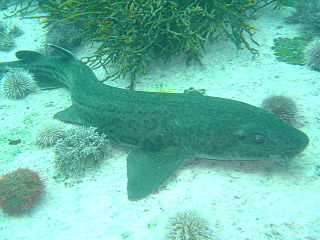
The leopard catshark is a species of catshark, and part of the family Scyliorhinidae, endemic to the coastal waters of South Africa. Abundant in inshore waters under 20 m (66 ft) deep, this bottom-dweller favors rocky reefs, kelp beds, and sandy flats. Growing to a length of 84 cm (33 in), the leopard catshark has a stout body with two dorsal fins placed well back, and a short head and tail. It is extremely variable in color and pattern, with individuals ranging from almost white to black and covered by diverse patterns of black spots, blotches, rosettes, and/or lines. The color pattern changes with age and some forms seem to be location-specific, suggesting the presence of multiple distinct, local populations. In the past, some of the more distinct color forms have been described as different species.

The longnose pygmy shark is a rare species of squaliform shark in the family Dalatiidae and the only member its genus. It is known only from a handful of specimens collected from the cold oceanic waters of the Southern Hemisphere, between the surface and a depth of 502 m (1,647 ft). Reaching 37 cm (15 in) in length, this diminutive shark is characterized by a slender, dark brown body with a very long, bulbous snout. In addition, it has two spineless dorsal fins of nearly equal size, with the origin of the first lying over the pectoral fin bases. The longnose pygmy shark does not appear substantially threatened by fisheries, and has been assessed as Least Concern by the International Union for Conservation of Nature (IUCN).
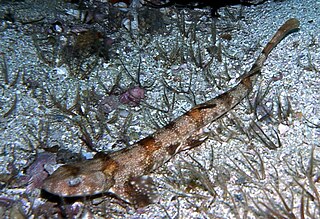
The puffadder shyshark, also known as the Happy Eddie, is a species of catshark, belonging to the family Scyliorhinidae, endemic to the temperate waters off the coast of South Africa. This common shark is found on or near the bottom in sandy or rocky habitats, from the intertidal zone to a depth of 130 m (430 ft). Typically reaching 60 cm (24 in) in length, the puffadder shyshark has a slender, flattened body and head. It is strikingly patterned with a series of dark-edged, bright orange "saddles" and numerous small white spots over its back. The Natal shyshark, formally described in 2006, was once considered to be an alternate form of the puffadder shyshark.

The brown shyshark or plain happy is a species of catshark, part of the family Scyliorhinidae. It is endemic to the shallow, coastal waters of South Africa from west of Cape Agulhas to KwaZulu-Natal. This benthic species is usually found over sandy or rocky bottoms. Measuring up to 73 cm (29 in) long, the brown shyshark is stoutly built, with a broad, flattened head and rounded snout. Unlike other shysharks, the brown shyshark has a plain brown color, though some individuals have faint "saddle" markings or light or dark spots. When threatened, this shark curls into a circle with its tail over its eyes, which is the origin of the name "shyshark". It feeds on bony fishes and lobsters, and is oviparous with females laying pairs of egg capsules. The International Union for Conservation of Nature (IUCN) has assessed this harmless species as Vulnerable. It is of no commercial or recreational interest, but its limited distribution makes its entire population vulnerable to increases in fishing pressure or habitat degradation.

The tiger catshark is a species of catshark, belonging to the family Scyliorhinidae. It is found over sandy areas and near reef peripheries off South Africa and perhaps Mozambique, from close to shore to usually no deeper than 100 m (330 ft). Reaching a length of 50 cm (20 in), this small, slim shark has a broad, flattened head with an upturned snout tip. It can additionally be identified by its dorsal colour pattern of ten dark brown saddles on a yellowish brown background.

The comber is a species of marine ray-finned fish from the family Serranidae, the sea basses. It is widely distributed in the eastern North and South Atlantic Oceans and into the southwestern Indian Ocean. It is caught for food and fishmeal in some parts of its range.

The black-spotted torpedo is a poorly known, uncommon species of electric ray in the family Torpedinidae, known for being capable of generating an electric shock. It is endemic to southern Africa and possibly several small Indian Ocean islands, although the latter reports may represent undescribed new species. Its appearance is similar to the Gulf torpedo, but it is duller in coloration.

Epinephelus andersoni, the catface grouper, brown-spotted grouper, catface rockcod or brown spotted rockcod, is a species of marine ray-finned fish, a grouper from the subfamily Epinephelinae which is part of the family Serranidae, which also includes the anthias and sea basses. It is found in the southwestern Indian Ocean where it is associated with reefs.

The round scad is a species of fish in the Carangidae. It was described in 1829 by the French naturalist and zoologist, Georges Cuvier. Although the round scad is considered a good food fish, it is mostly caught for use as bait.

Cirrhibarbis capensis, the barbelled klipfish, is a species of clinid found in subtropical waters of the Atlantic Ocean around South Africa. This species can reach a maximum length of 36 centimetres (14 in) TL. This species preys primarily on benthic crustaceans, mostly amphipods and isopods. It is currently the only known member of its genus.
Blennophis anguillaris, the snaky klipfish, is a species of clinid found in the subtropical waters of the Atlantic Ocean around South Africa. It can be found in the subtidal zone and also is a denizen of tidepools. This species can reach a maximum length of 30 centimetres (12 in) TL.
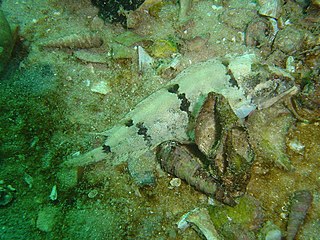
Clinus agilis, the agile klipfish, is a species of clinid found in subtropical waters of the Atlantic Ocean from Namibia to South Africa where it is commonly found in estuaries and tide pools. This species can reach a maximum length of 10 centimetres (3.9 in).
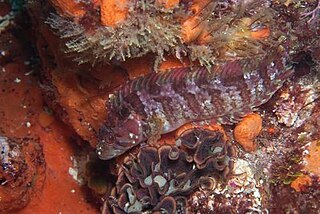
Clinus berrisfordi, the Onrust klipfish, is a species of clinid that occurs in subtropical waters of the Atlantic Ocean from False Bay to Skoenmakerskop, South Africa where it prefers marine and brackish habitats with plentiful growth of seaweed. This species can reach a maximum length of 12 centimetres (4.7 in) TL.
Clinus brevicristatus, the Cape klipfish, is a species of clinid that occurs in subtropical waters of the Atlantic Ocean around South Africa where it prefers habitats with plentiful growth of seaweed. This species can reach a maximum length of 12 centimetres (4.7 in) TL.
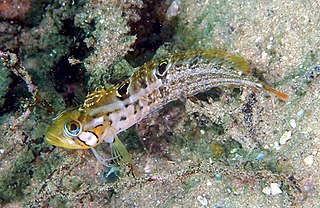
Clinus venustris, the speckled klipfish, is a species of clinid that occurs in subtropical waters of the Atlantic Ocean from Namibia to South Africa where it is found in the subtidal zone as well as being a denizen of tide pools. This species can reach a maximum length of 12 centimetres (4.7 in) TL. and feeds primarily on amphipods, isopods, mysids, and echinoderms.

Merluccius capensis is a ray-finned fish in the genus Merluccius, found in the south-eastern Atlantic Ocean, along the coast of South Africa. It is a long, lean fish with a large head, similar in appearance to the European hake and the deep-water Cape hake. By day, it lives close to the bottom on the continental shelf and upper slope at depths not usually exceeding 400 m (1,300 ft); it makes a large, daily vertical migration rising at night to feed in the nectonic zone, and it also migrates southwards in spring and northwards in autumn. It is an important commercial fish species in southern Africa.

The onefin electric ray or Cape numbfish is a common but little-known species of electric ray in the family Narkidae, native to South Africa and Namibia. It is a benthic fish found in shallow coastal bays over sandy or muddy bottoms. This small species reaches 38 cm (15 in) in length, and has a nearly circular pectoral fin disc and a short, muscular tail that supports a large caudal fin. It can be identified by its single dorsal fin, which is located over the large pelvic fins. Its dorsal coloration is yellowish to dusky brown.

Argyrosomus inodorus, the mild meagre or silver kob, is a species of marine ray-finned fish belonging to the family Sciaenidae, the drums and croakers. The species is found off southern Africa where it is an important target species for hook and line fisheries.

















